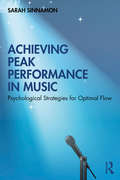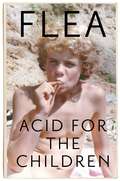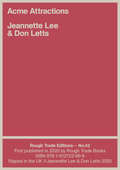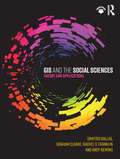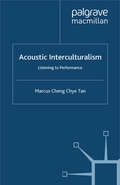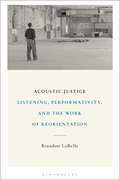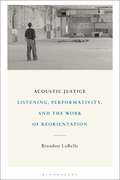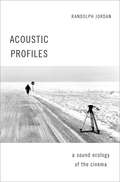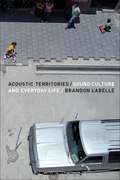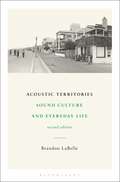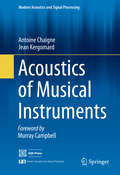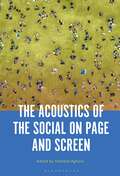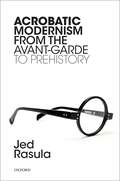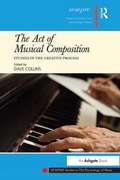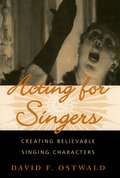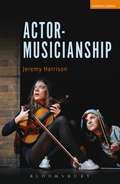- Table View
- List View
Achieving Peak Performance in Music: Psychological Strategies for Optimal Flow
by Sarah SinnamonAchieving Peak Performance in Music: Psychological Strategies for Optimal Flow is a unique and comprehensive exploration of flow in music performance. It describes the optimal performance experiences of great musicians and outlines ten psychological steps that can be implemented to facilitate and enhance optimal experience. Achieving Peak Performance in Music reveals strategies used by experts to prepare themselves emotionally, cognitively, and physically for performance. Combining this information with research carried out amongst professional performers and knowledge gained from decades of study and research by psychologists on how to achieve a positive experience, the book guides readers on a pathway towards optimal performance. Using everyday language, it presents invaluable practical guidance and a toolbox of strategies to help with all aspects of performance, including memorisation, visualisation, focus, performance anxiety, thought management, motivation, and pre-performance routines. Based on psychological research, the book shares practical knowledge invaluable to music students, parents, and amateur and professional musicians. The strategies on performance provided are applicable to every type of performance, from a student exam to a gig or a concert, making Achieving Peak Performance in Music a significant resource for anyone looking to achieve peak performance.
Acid For The Children - The autobiography of Flea, the Red Hot Chili Peppers legend: A Memoir
by FleaFlea, the iconic bassist and co-founder, alongside Anthony Kiedis, of the immortal Red Hot Chili Peppers finally tells his fascinating origin story, complete with all the dizzying highs and the gutter lows you'd expect from an LA street rat turned world-famous rock star.Michael Peter Balzary was born in Melbourne, Australia, on October 16, 1962. His more famous stage name, Flea, and his wild ride as the renowned bass player for the Red Hot Chili Peppers was in a far and distant future. Little Michael from Oz moved with his very conservative, very normal family to Westchester, New York, where life as he knew it was soon turned upside down. His parents split up and he and his sister moved into the home of his mother's free-wheeling, jazz musician boyfriend - trading in rules, stability, and barbecues for bohemian values, wildness, and Sunday afternoon jazz parties where booze, weed, and music flowed in equal measure. There began Michael's life-long journey to channel all the frustration, loneliness, love, and joy he felt into incredible rhythm.When Michael's family moved to Los Angeles in 1972, his home situation was rockier than ever. He sought out a sense of belonging elsewhere, spending most of his days partying, playing basketball, and committing petty crimes. At Fairfax High School, he met another social outcast, Anthony Kiedis, who quickly became his soul brother, the yin to his yang, his partner in mischief. Michael joined some bands, fell in love with performing, and honed his skills. But it wasn't until the night when Anthony, excited after catching a Grandmaster Flash concert, suggested they start their own band that he is handed the magic key to the cosmic kingdom.Acid for the Children is as raw, entertaining and wildly unpredictable as its author. It's both a tenderly evocative coming of age story and a raucous love letter to the power of music and creativity.
Acme Attractions (Rough Trade Edition #42)
by Don Letts Jeannette LeeAcme Attractions tells the story of a place, and its people, that found themselves at the heart of one of the country’s great cultural moments. While living and working through a now-legendary period of the capital’s history, Don Letts and Jeannette Lee found themselves simultaneously experiencing the pleasures and pitfalls of youth while witnessing the birth and heady, early excitement of punk. Their story, told here through a conversation that is warm, intelligent and compelling, touches on the revolutionary feelings of that time, as fashion, politics, music and art were all re-made in real time and, as we now know, things would never be the same again.
Acoustemologies in Contact: Sounding Subjects and Modes of Listening in Early Modernity
by Emily Wilbourne and Suzanne G. CusickIn this fascinating collection of essays, an international group of scholars explores the sonic consequences of transcultural contact in the early modern period. They examine how cultural configurations of sound impacted communication, comprehension, and the categorisation of people. Addressing questions of identity, difference, sound, and subjectivity in global early modernity, these authors share the conviction that the body itself is the most intimate of contact zones, and that the culturally contingent systems by which sounds made sense could be foreign to early modern listeners and to present day scholars. Drawing on a global range of archival evidence—from New France and New Spain, to the slave ships of the Middle Passage, to China, Europe, and the Mediterranean court environment—this collection challenges the privileged position of European acoustical practices within the discipline of global-historical musicology. The discussion of Black and non-European experiences demonstrates how the production of ‘the canon’ in the cosmopolitan centres of colonial empires was underpinned by processes of human exploitation and extraction of resources. As such, this text is a timely response to calls within the discipline to decolonise music history and to contextualise the canonical works of the European past. This volume is accessible to a wide and interdisciplinary audience, not only within musicology, but also to those interested in early modern global history, sound studies, race, and slavery.
Acoustic And Midi Orchestration For The Contemporary Composer: A Practical Guide To Writing And Sequencing For The Studio Orchestra (PDF)
by Andrea Pejrolo Rich DeRosaAcoustic and MIDI Orchestration for the Contemporary Composer, Second Edition provides effective explanations and illustrations to teach you how to integrate traditional approaches to orchestration with the use of the modern sequencing techniques and tools available to today’s composer. By covering both approaches, Pejrolo and DeRosa offer a comprehensive and multifaceted learning experience that will develop your orchestration and sequencing skills and enhance your final productions. A leading manual on its subject, the second edition allows experienced composers and producers to be exposed to sequencing techniques applied to traditional writing and arranging styles. The book continues to provide a comprehensive and solid learning experience and has been fully revised to include the latest tools and techniques. The new edition has been updated to include: A new chapter on cover writing and sequencing for vocal ensembles Coverage of writing for different ensemble sizes A new final chapter on writing and production techniques for mixed contemporary ensembles. All new techniques, tools, and sound libraries available to today’s composer. A companion website (www.routledge.com/cw/pejrolo) includes a wide selection of audio examples, templates, sounds, and videos showcasing operational processes, allows you the opportunity to listen to the techniques discussed within the book.
Acoustic And Midi Orchestration For The Contemporary Composer: A Practical Guide To Writing And Sequencing For The Studio Orchestra
by Andrea Pejrolo Rich DeRosaAcoustic and MIDI Orchestration for the Contemporary Composer, Second Edition provides effective explanations and illustrations to teach you how to integrate traditional approaches to orchestration with the use of the modern sequencing techniques and tools available to today’s composer. By covering both approaches, Pejrolo and DeRosa offer a comprehensive and multifaceted learning experience that will develop your orchestration and sequencing skills and enhance your final productions. A leading manual on its subject, the second edition allows experienced composers and producers to be exposed to sequencing techniques applied to traditional writing and arranging styles. The book continues to provide a comprehensive and solid learning experience and has been fully revised to include the latest tools and techniques. The new edition has been updated to include: A new chapter on cover writing and sequencing for vocal ensembles Coverage of writing for different ensemble sizes A new final chapter on writing and production techniques for mixed contemporary ensembles. All new techniques, tools, and sound libraries available to today’s composer. A companion website (www.routledge.com/cw/pejrolo) includes a wide selection of audio examples, templates, sounds, and videos showcasing operational processes, allows you the opportunity to listen to the techniques discussed within the book.
Acoustic Interculturalism: Listening to Performance (Studies in International Performance)
by Marcus Cheng TanAcoustic Interculturalism is a study of the soundscapes of intercultural performance through the examination of sound's performativity. Employing an interdisciplinary approach, the book examines an akoumenological reception of sound to postulate the need for an acoustic knowing – an awareness of how sound shapes the intercultural experience.
Acoustic Justice: Listening, Performativity, and the Work of Reorientation
by Brandon LaBelleAcoustic Justice engages issues of recognition and misrecognition by mobilizing an acoustic framework. From the vibrational intensities of common life to the rhythm of bodies in movement, and drawing from his ongoing work on sound and agency, Brandon LaBelle positions acoustics, and the broader experience of listening, as a dynamic means for fostering responsiveness, understanding, dispute, and the work of reorientation. As such, acoustic justice emerges as a compelling platform for engaging struggles over the right to speak and to be heard that extends toward a broader materialist and planetary view. This entails critically addressing questions of space, borders, community, and the acoustic norms defining capacities of listening, leading to what LaBelle terms “poetic ecologies of resonance.” Acoustic Justice works at issues of recognition and resistance, place and displacement, by moving across a range of pertinent references and topics, from social practices and sound art to the performativity of skin and the poetics of Deaf voice. Through such transversality, LaBelle pushes for acoustics as the basis for strategies of refusal and repair.
Acoustic Justice: Listening, Performativity, and the Work of Reorientation
by Brandon LaBelleAcoustic Justice engages issues of recognition and misrecognition by mobilizing an acoustic framework. From the vibrational intensities of common life to the rhythm of bodies in movement, and drawing from his ongoing work on sound and agency, Brandon LaBelle positions acoustics, and the broader experience of listening, as a dynamic means for fostering responsiveness, understanding, dispute, and the work of reorientation. As such, acoustic justice emerges as a compelling platform for engaging struggles over the right to speak and to be heard that extends toward a broader materialist and planetary view. This entails critically addressing questions of space, borders, community, and the acoustic norms defining capacities of listening, leading to what LaBelle terms “poetic ecologies of resonance.” Acoustic Justice works at issues of recognition and resistance, place and displacement, by moving across a range of pertinent references and topics, from social practices and sound art to the performativity of skin and the poetics of Deaf voice. Through such transversality, LaBelle pushes for acoustics as the basis for strategies of refusal and repair.
Acoustic Profiles: A Sound Ecology of the Cinema (OXFORD MUSIC/MEDIA SERIES)
by Randolph JordanIn Acoustic Profiles, author Randolph Jordan proposes a new model for image-sound analysis that incorporates the vocabulary and methods of environmental studies, specifically exploring the potential of a model based on acoustic ecology. Jordan uses close readings of films to connect the diverse fields of architecture, environmental studies, art history, the history of modernity, and media studies through the tenets of acoustic ecology. In relating ways of thinking about sound from acoustic ecology to film studies and vice versa, Acoustic Profiles takes an interdisciplinary approach to inspire readers to experience cinematic art as a motivator of greater environmental purposes and to understand the role of the media in achieving those purposes. The book's method is referred to as acoustic profiling, a theoretical tool for hearing how filmmakers articulate spatial dimensions in their works. To that end, the book demonstrates how the creative use of media technologies in different fields can be understood relationally through the ecological issues that connect them, revivifying acoustic ecology for media studies while broadening the latter's ecological scope. The book provides a tool kit for readers to hear films with new ears, to think critically about this new listening practice, and to extend that engagement beyond the walls of the screening room by opening works of audiovisual media up to the consideration of soundscape research.
Acoustic Profiles: A Sound Ecology of the Cinema (OXFORD MUSIC/MEDIA SERIES)
by Randolph JordanIn Acoustic Profiles, author Randolph Jordan proposes a new model for image-sound analysis that incorporates the vocabulary and methods of environmental studies, specifically exploring the potential of a model based on acoustic ecology. Jordan uses close readings of films to connect the diverse fields of architecture, environmental studies, art history, the history of modernity, and media studies through the tenets of acoustic ecology. In relating ways of thinking about sound from acoustic ecology to film studies and vice versa, Acoustic Profiles takes an interdisciplinary approach to inspire readers to experience cinematic art as a motivator of greater environmental purposes and to understand the role of the media in achieving those purposes. The book's method is referred to as acoustic profiling, a theoretical tool for hearing how filmmakers articulate spatial dimensions in their works. To that end, the book demonstrates how the creative use of media technologies in different fields can be understood relationally through the ecological issues that connect them, revivifying acoustic ecology for media studies while broadening the latter's ecological scope. The book provides a tool kit for readers to hear films with new ears, to think critically about this new listening practice, and to extend that engagement beyond the walls of the screening room by opening works of audiovisual media up to the consideration of soundscape research.
Acoustic Territories: Sound Culture and Everyday Life
by Brandon LaBelleAcoustic Territories: Sound Culture and Everyday Life offers an expansive reading of auditory life. It provides a careful consideration of the performative dynamics inherent to sound culture and acts of listening, and discusses how auditory studies may illuminate understandings of contemporary society. Combining research on urbanism, popular culture and auditory issues, Acoustic Territories opens up multiple perspectives - it challenges debates surrounding noise pollution and charts an "acoustic politics of space" by unfolding auditory experience as located within larger cultural histories and related ideologies.Brandon LaBelle traces auditory life through a topographic structure: beginning with underground territories, through to the home as a site, and then further, to streets and neighborhoods, and finally to the sky itself. This structure follows sound as it appears in specific auditory designs, as it is mobilized within various cultural projects, and queries how it comes to circulate through everyday life as a medium for social transformation. Acoustic Territories uncovers the embedded tensions and potentiality inherent to sound as it exists in the everyday spaces around us.
Acoustic Territories: Sound Culture and Everyday Life
by Brandon LaBelleAcoustic Territories: Sound Culture and Everyday Life offers an expansive reading of auditory life. It provides a careful consideration of the performative dynamics inherent to sound culture and acts of listening, and discusses how auditory studies may illuminate understandings of contemporary society. Combining research on urbanism, popular culture and auditory issues, Acoustic Territories opens up multiple perspectives - it challenges debates surrounding noise pollution and charts an "acoustic politics of space" by unfolding auditory experience as located within larger cultural histories and related ideologies.Brandon LaBelle traces auditory life through a topographic structure: beginning with underground territories, through to the home as a site, and then further, to streets and neighborhoods, and finally to the sky itself. This structure follows sound as it appears in specific auditory designs, as it is mobilized within various cultural projects, and queries how it comes to circulate through everyday life as a medium for social transformation. Acoustic Territories uncovers the embedded tensions and potentiality inherent to sound as it exists in the everyday spaces around us.
Acoustic Territories, Second Edition: Sound Culture and Everyday Life
by Brandon LaBelleThe revised edition of Acoustic Territories: Sound Culture and Everyday Life offers an expansive reading of auditory life. It provides a careful consideration of the performative dynamics inherent to sounding and listening, and discusses how sound studies may illuminate understandings of contemporary society. Combining research on urbanism, popular culture, street life and sonic technologies, Acoustic Territories opens up a range of critical perspectives--it challenges debates surrounding noise pollution and charts an "acoustic politics of space" by engaging auditory experience as found within particular cultural histories and related ideologies. Brandon LaBelle traces sound culture through a topographic structure: from underground territories to the home, and further, into the rhythms and vibrations of streets and neighborhoods, and finally to the sky itself as an arena of transmitted imaginaries. The new edition includes an additional "global territory" of the relational, positioning acoustics as a range of everyday practices that rework dominant tonalities. Questions of orientation and emplacement are critically raised, reframing listening as multi-modal and intrinsic to resistant socialities and what the author terms "acts of compositioning." The book is fully updated to include new relevant research and references surfacing since 2010, as well as a new preface to the second edition. Acoustic Territories continues to uncover the embedded tensions and potentialities inherent to sound as it exists in the everyday spaces around us.
Acoustic Territories, Second Edition: Sound Culture and Everyday Life
by Brandon LaBelleThe revised edition of Acoustic Territories: Sound Culture and Everyday Life offers an expansive reading of auditory life. It provides a careful consideration of the performative dynamics inherent to sounding and listening, and discusses how sound studies may illuminate understandings of contemporary society. Combining research on urbanism, popular culture, street life and sonic technologies, Acoustic Territories opens up a range of critical perspectives--it challenges debates surrounding noise pollution and charts an "acoustic politics of space" by engaging auditory experience as found within particular cultural histories and related ideologies. Brandon LaBelle traces sound culture through a topographic structure: from underground territories to the home, and further, into the rhythms and vibrations of streets and neighborhoods, and finally to the sky itself as an arena of transmitted imaginaries. The new edition includes an additional "global territory" of the relational, positioning acoustics as a range of everyday practices that rework dominant tonalities. Questions of orientation and emplacement are critically raised, reframing listening as multi-modal and intrinsic to resistant socialities and what the author terms "acts of compositioning." The book is fully updated to include new relevant research and references surfacing since 2010, as well as a new preface to the second edition. Acoustic Territories continues to uncover the embedded tensions and potentialities inherent to sound as it exists in the everyday spaces around us.
Acoustics of Musical Instruments (Modern Acoustics and Signal Processing)
by Antoine Chaigne Jean KergomardThis book, the first English-language translation of Acoustique des instruments de musique, Second Edition, presents the necessary foundations for understanding the complex physical phenomena involved in musical instruments. What is the function of the labium in a flute? Which features of an instrument allow us to make a clear audible distinction between a clarinet and a trumpet? With the help of numerous examples, these questions are addressed in detail. The authors focus in particular on the significant results obtained in the field during the last fifteen years. Their goal is to show that elementary physical models can be used with benefit for various applications in sound synthesis, instrument making, and sound recording. The book is primarily addressed to graduate students and researchers; however it could also be of interest for engineers, musicians, craftsmen, and music lovers who wish to learn about the basics of musical acoustics.
The Acoustics of the Social on Page and Screen
by Nathalie AghoroSound positions individuals as social subjects. The presence of human beings, animals, objects, or technologies reverberates into the spaces we inhabit and produces distinct soundscapes that render social practices, group associations, and socio-cultural tensions audible. The Acoustics of the Social on Page and Screen unites interdisciplinary perspectives on the social dimensions of sound in audiovisual and literary environments. The essays in the collection discuss soundtracks for shared values, group membership, and collective agency, and engage with the subversive functions of sound and sonic forms of resistance in American literature, film, and TV.
The Acoustics of the Social on Page and Screen
Sound positions individuals as social subjects. The presence of human beings, animals, objects, or technologies reverberates into the spaces we inhabit and produces distinct soundscapes that render social practices, group associations, and socio-cultural tensions audible. The Acoustics of the Social on Page and Screen unites interdisciplinary perspectives on the social dimensions of sound in audiovisual and literary environments. The essays in the collection discuss soundtracks for shared values, group membership, and collective agency, and engage with the subversive functions of sound and sonic forms of resistance in American literature, film, and TV.
Acrobatic Modernism from the Avant-Garde to Prehistory
by Jed RasulaThis is a book about artistic modernism contending with the historical transfigurations of modernity. As a conscientious engagement with modernity's restructuring of the lifeworld, the modernist avant-garde raised the stakes of this engagement to programmatic explicitness. But even beyond the vanguard, the global phenomenon of jazz combined somatic assault with sensory tutelage. Jazz, like the new technologies of modernity, re-calibrated sensory ratios. The criterion of the new as self-making also extended to names: pseudonyms and heteronyms. The protocols of modernism solicited a pragmatic arousal of bodily sensation as artistic resource, validating an acrobatic sensibility ranging from slapstick and laughter to the pathos of bereavement. Expressivity trumped representation. The artwork was a diagram of perception, not a mimetic rendering. For artists, the historical pressures of altered perception provoked new models, and Ezra Pound's slogan 'Make It New' became the generic rallying cry of renovation. The paradigmatic stance of the avant-garde was established by Futurism, but the discovery of prehistoric art added another provocation to artists. Paleolithic caves validated the spirit of all-over composition, unframed and dynamic. Geometric abstraction, Constructivism and Purism, and Surrealism were all in quest of a new mythology. Making it new yielded a new pathos in the sensation of radical discrepancy between futurist striving and remotest antiquity. The Paleolithic cave and the USSR emitted comparable siren calls on behalf of the remote past and the desired future. As such, the present was suffused with the pathos of being neither, but subject to both.
Acrobatic Modernism from the Avant-Garde to Prehistory
by Jed RasulaThis is a book about artistic modernism contending with the historical transfigurations of modernity. As a conscientious engagement with modernity's restructuring of the lifeworld, the modernist avant-garde raised the stakes of this engagement to programmatic explicitness. But even beyond the vanguard, the global phenomenon of jazz combined somatic assault with sensory tutelage. Jazz, like the new technologies of modernity, re-calibrated sensory ratios. The criterion of the new as self-making also extended to names: pseudonyms and heteronyms. The protocols of modernism solicited a pragmatic arousal of bodily sensation as artistic resource, validating an acrobatic sensibility ranging from slapstick and laughter to the pathos of bereavement. Expressivity trumped representation. The artwork was a diagram of perception, not a mimetic rendering. For artists, the historical pressures of altered perception provoked new models, and Ezra Pound's slogan 'Make It New' became the generic rallying cry of renovation. The paradigmatic stance of the avant-garde was established by Futurism, but the discovery of prehistoric art added another provocation to artists. Paleolithic caves validated the spirit of all-over composition, unframed and dynamic. Geometric abstraction, Constructivism and Purism, and Surrealism were all in quest of a new mythology. Making it new yielded a new pathos in the sensation of radical discrepancy between futurist striving and remotest antiquity. The Paleolithic cave and the USSR emitted comparable siren calls on behalf of the remote past and the desired future. As such, the present was suffused with the pathos of being neither, but subject to both.
The Act of Musical Composition: Studies in the Creative Process (SEMPRE Studies in The Psychology of Music)
by Dave CollinsThe study of musical composition has been marked by a didactic, technique-based approach, focusing on the understanding of musical language and grammar -harmony, counterpoint, orchestration and arrangement - or on generic and stylistic categories. In the field of the psychology of music, the study of musical composition, even in the twenty-first century, remains a poor cousin to the literature which relates to musical perception, music performance, musical preferences, musical memory and so on. Our understanding of the compositional process has, in the main, been informed by anecdotal after-the-event accounts or post hoc analyses of composition. The Act of Musical Composition: Studies in the Creative Process presents the first coherent exploration around this unique aspect of human creative activity. The central threads, or key themes - compositional process, creative thinking and problem-solving - are integrated by the combination of theoretical understandings of creativity with innovative empirical work.
The Act of Musical Composition: Studies in the Creative Process (SEMPRE Studies in The Psychology of Music)
by Dave CollinsThe study of musical composition has been marked by a didactic, technique-based approach, focusing on the understanding of musical language and grammar -harmony, counterpoint, orchestration and arrangement - or on generic and stylistic categories. In the field of the psychology of music, the study of musical composition, even in the twenty-first century, remains a poor cousin to the literature which relates to musical perception, music performance, musical preferences, musical memory and so on. Our understanding of the compositional process has, in the main, been informed by anecdotal after-the-event accounts or post hoc analyses of composition. The Act of Musical Composition: Studies in the Creative Process presents the first coherent exploration around this unique aspect of human creative activity. The central threads, or key themes - compositional process, creative thinking and problem-solving - are integrated by the combination of theoretical understandings of creativity with innovative empirical work.
Acting for Singers: Creating Believable Singing Characters
by David F. OstwaldWritten to meet the needs of thousands of students and pre-professional singers participating in production workshops and classes in opera and musical theater, Acting for Singers leads singing performers step by step from the studio or classroom through audition and rehearsals to a successful performance. Using a clear, systematic, positive approach, this practical guide explains how to analyze a script or libretto, shows how to develop a character building on material in the score, and gives the singing performer the tools to act believably. More than just a "how-to" acting book, however, Acting for Singers also addresses the problems of concentration, trust, projection, communication, and the self-doubt that often afflicts singers pursuing the goal of believable performance. Part I establishes the basic principles of acting and singing together, and teaches the reader how to improvise as a key tool to explore and develop characters. Part II teaches the singer how to analyze theatrical work for rehearsing and performing. Using concrete examples from Carmen and West Side Story, and imaginative exercises following each chapter, this text teaches all singers how to be effective singing actors.
Acting for Singers: Creating Believable Singing Characters
by David F. OstwaldWritten to meet the needs of thousands of students and pre-professional singers participating in production workshops and classes in opera and musical theater, Acting for Singers leads singing performers step by step from the studio or classroom through audition and rehearsals to a successful performance. Using a clear, systematic, positive approach, this practical guide explains how to analyze a script or libretto, shows how to develop a character building on material in the score, and gives the singing performer the tools to act believably. More than just a "how-to" acting book, however, Acting for Singers also addresses the problems of concentration, trust, projection, communication, and the self-doubt that often afflicts singers pursuing the goal of believable performance. Part I establishes the basic principles of acting and singing together, and teaches the reader how to improvise as a key tool to explore and develop characters. Part II teaches the singer how to analyze theatrical work for rehearsing and performing. Using concrete examples from Carmen and West Side Story, and imaginative exercises following each chapter, this text teaches all singers how to be effective singing actors.
Actor-Musicianship (Performance Books)
by Jeremy HarrisonActor-musicianship is a permanent feature of the musical theatre landscape. Actor-musician shows can be seen from Bradford to Broadway, from village halls to international arena tours. However, with the exception of a couple of academic papers, there has been nothing written about this fascinating area of theatre practice. Jeremy Harrison's book addresses this deficit, operating as both a record of the development of the actor-musician movement and as a practical guide for students, educators, performers and practitioners. It explores the history of actor-musicianship, examining its origins, as well as investigating – and offering guidance on – how this specialist form of music theatre is created. It, in turn, acts as a means of defining an art form that has to date been left to lurk in the shadows of musical theatre; a subset with its own distinctive culture of performer, maker and audience, but as yet no formal recognition as a specialism in its own right. The actor-musician show is multifarious and as such this book targets those interested in mainstream commercial work, as well as alternative and avant-garde theatre practice. The book draws together expertise from a range of disciplines with contributions from many of the leading figures in this field, including performers, directors, teachers, MDs, producers and writers. It also features a foreword by theatre director John Doyle.
